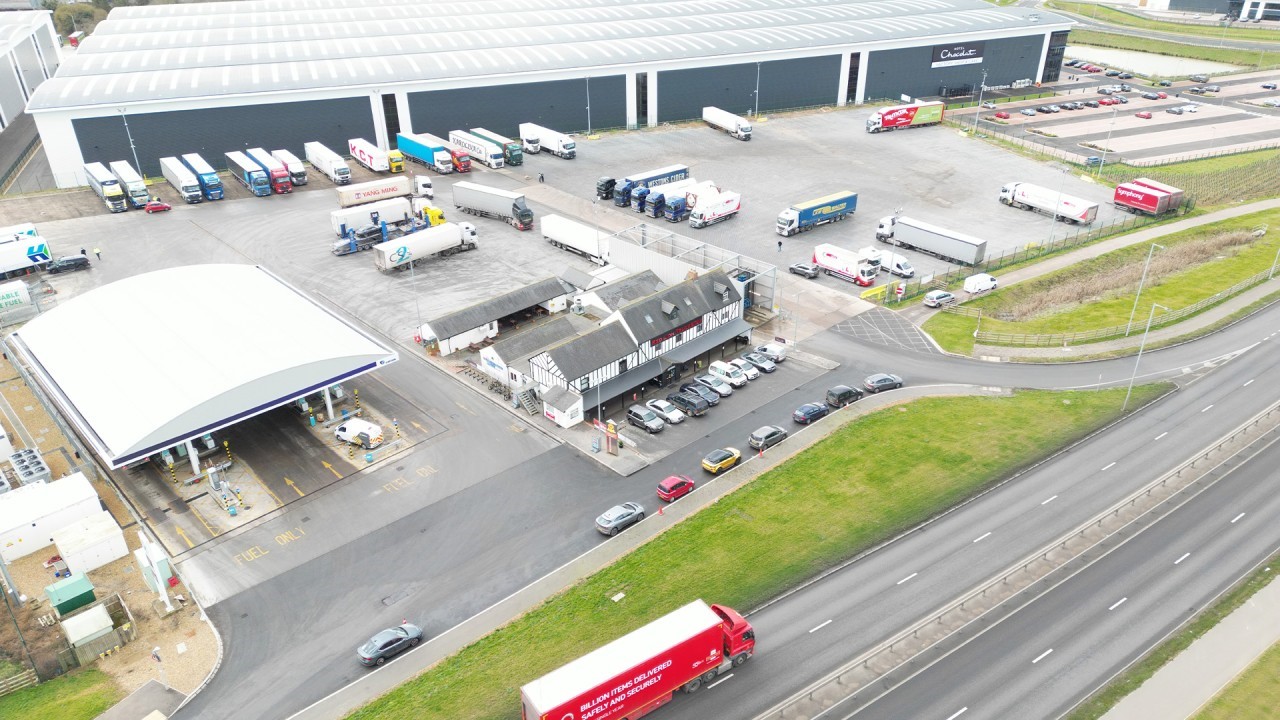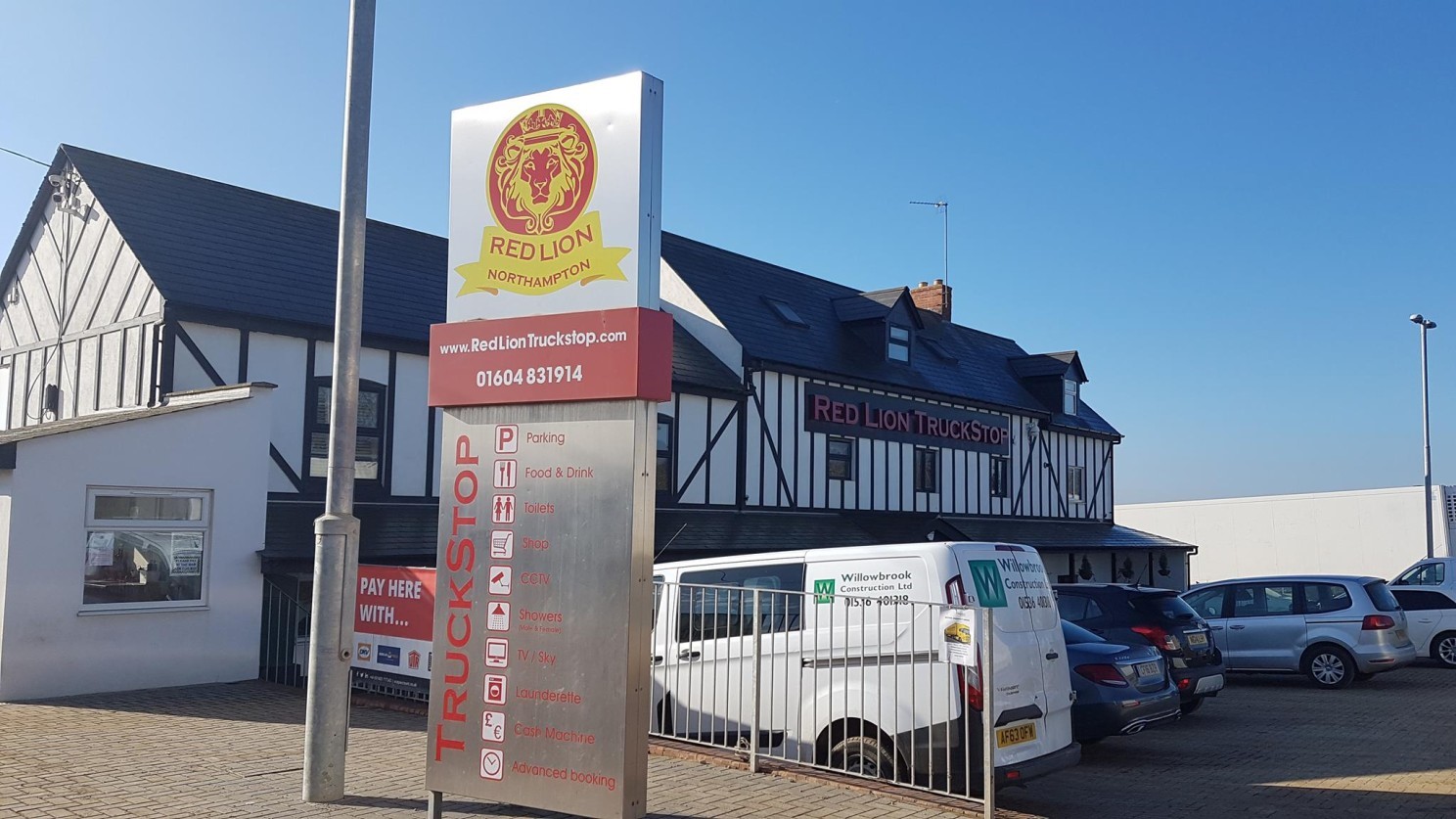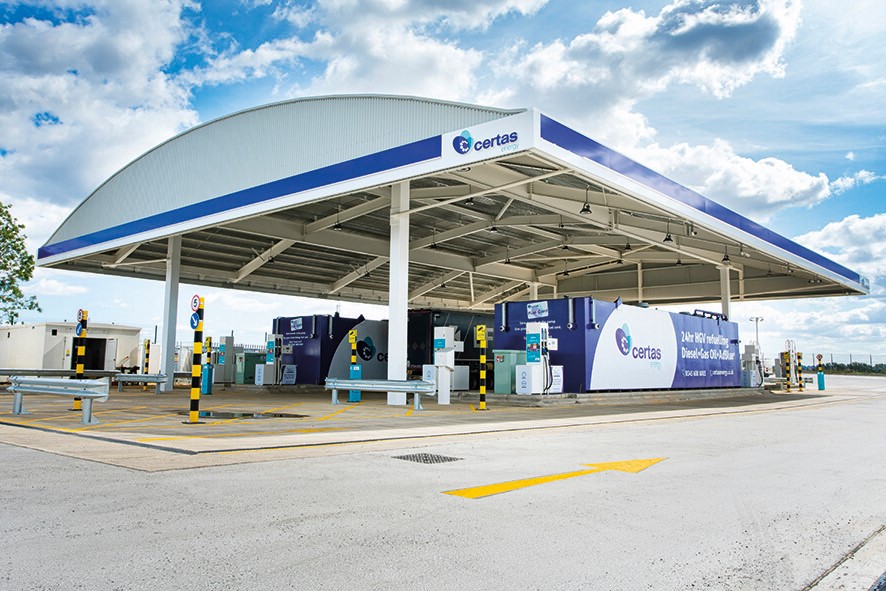
Susie Jones
Zastávka Red Lion Truckstop - vzor úspechu
Vytvorené: 28. 08. 2024
•
Aktualizované: 28. 08. 2024
Len 200 metrov od diaľnice M1 na križovatke 16 sa nachádza zastávka pre kamióny Red Lion. Založené pred viac ako 30 rokmi sa Red Lion stalo obľúbeným miestom pre vodičov. Vďaka svojej komunitnej atmosfére, chutnému jedlu a širokej ponuke zariadení je táto oceňovaná zastávka obľúbená. Prevádzkovateľ zariadenia Ali Sadrudin nám o ňom povedal.
"Do areálu sa zmestí viac ako 200 nákladných vozidiel za noc. K dispozícii je vysokorýchlostná čerpacia stanica pohonných hmôt, ktorá vydáva nielen naftu a AdBlue, ale aj stlačený zemný plyn (CNG). K dispozícii je aj novovybudovaná umývačka nákladných vozidiel s obsluhou s tromi kefami. V budove občianskej vybavenosti sa nachádza reštaurácia a bar, obchod s príslušenstvom pre nákladné vozidlá, práčovňa, herné centrum, bankomaty, sprchy a toalety s obsluhou a priestory pre funkcie a stretnutia."

Zariadenia
Niektorí môžu zastávky pre nákladné vozidlá považovať len za miesto odpočinku pre vodičov, ale zohrávajú aj kľúčovú úlohu pri zlepšovaní pohody vodičov. V spoločnosti SNAP vieme, že je nevyhnutné poskytnúť vodičom čisté priestory. Čo však ešte potrebujú vodiči nákladných vozidiel?
"Verím, že zákazníci hľadajú základné veci, ale správne spracované. Dobré jedlo, čisté priestory a bezpečnosť ich vozidiel a nákladu. Ak to dokážete zabezpečiť, budete mať spokojných a opakovaných zákazníkov," hovorí Ali.
Stačí sa pozrieť na stránku Red Lion na Facebooku a zistíte, že sa touto mantrou určite riadia a funguje to. Komentáre ako "úžasná zastávka pre kamióny, najlepšia v krajine" a "pravdepodobne jedna z najlepších zastávok pre kamióny v Anglicku" podporujú viac ako 4 000 pozitívnych hodnotení v službe Google.
Bezpečnosť a ochrana
Chutné jedlá a čisté priestory však nie sú jediné, na čo sa Ali a jeho tím zameriavajú. Mimoriadne vážne berú aj bezpečnosť. Odhaduje sa, že v roku 2020 bolo v Spojenom kráľovstve spáchaných viac ako 4 000 trestných činov v oblasti nákladnej dopravy, prepravy tovaru a nákladnej dopravy - čo spôsobilo Spojenému kráľovstvu náklady vo výške 250 miliónov libier. Miesta ako Red Lion zaviedli bezpečnostné opatrenia na zníženie tohto počtu.
Ali tvrdí, že "SNAP nám pomohol získať certifikát TAPA PSR Level 3." Vo februári 2023 získala spoločnosť The Red Lion ocenenie Park Mark Freight Award. Ali nám hovorí o tom, aké bezpečnostné opatrenia boli prijaté na získanie tohto ocenenia.
"Stránka je bezpečná už od začiatku. Máme nepretržitú strážnu službu, ktorá hliadkuje v areáli, pričom tretia strana monitoruje kamerový systém. Okolo areálu máme 3 m neprerušovaný plot s pevnými kamerami, ktoré sa pozerajú na všetky jeho body, takže dokážu odhaliť akýkoľvek neoprávnený vstup alebo poškodenie plotových panelov. Areál je tiež plne osvetlený na požadovanú úroveň luxov, ktorú určila polícia, pričom kamery s detekciou pohybu sú strategicky rozmiestnené po celom areáli, aby zachytili akýkoľvek neoprávnený pohyb a zabezpečili, že každá časť areálu je pod dohľadom. Systém ANPR na zachytenie značiek vchádzajúcich do areálu a vychádzajúcich z neho a upozornenie na rýchlu reakciu polície v prípade potreby jej privolania."
Hotel Red Lion prijal aj ďalšie opatrenia, aby sa ženy-vodičky počas svojich návštev cítili pohodlne a bezpečne. K dispozícii je vybavenie ako dámske sprchy, toalety a šatne. Tieto opatrenia neostali bez povšimnutia, keďže v januári 2023 bolo toto odpočívadlo vyhlásené za najlepšie odpočívadlo pre ženy - vodičky nákladných vozidiel vo Veľkej Británii.

Príjmy a expanzia
Jednou z mnohých výhod pre manažérov lokalít, ktorí používajú SNAP, je lepšia ziskovosť a optimalizácia. Ali ako zakladajúci zákazník spoločnosti SNAP vysvetľuje, ako SNAP priniesol podniku od jeho pripojenia v roku 2009 dodatočné príjmy.
"Bol to postupný proces v priebehu rokov, ale keďže sa návyky vodičov neustále menia a stávajú sa bezhotovostnými, viem si predstaviť, že nové miesto, ktoré by prevzalo SNAP, by malo okamžitú návratnosť. Približne 65 % celkových príjmov stránky pochádza zo systému SNAP."
Od roku 2009 sa v tomto odvetví určite veľa zmenilo. Ali vysvetľuje, ako sa stránka musela prispôsobiť meniacemu sa odvetviu a zvýšenému dopytu.
"Spočiatku bol areál schopný pojať len 130 nákladných vozidiel za noc, ale v roku 2018 sa rozšíril na viac ako 200, aby vyhovel zvýšenému dopytu," uvádza Ali. Pre vodičov a vozové parky využívajúce SNAP sa týchto 200 miest stáva ľahko rezervovateľných.
Len o štyri roky neskôr sa areál rozšíril o novú umývareň nákladných vozidiel. Moderná umývačka nákladných vozidiel s tromi kefami, otvorená v novembri 2022, je vhodná pre väčšinu vozidiel LGV.

Vstup do SNAP ako partner služby
Vstupom do SNAP sa vaša lokalita dostane do povedomia 160 000 vodičov a 7 000 vozových parkov. Zastávkam pre nákladné vozidlá, ako je Red Lion, ktoré sa neustále snažia ponúkať nové iniciatívy a zariadenia pre svojich zákazníkov, poskytuje SNAP túto príležitosť.
"SNAP umožnil stránke ponúknuť alternatívny spôsob platby, ktorý môže byť pre zákazníka len prínosom a prilákať ho na stránku," hovorí Ali.
Výhody SNAP
Viac ako 160 000 vodičov používa účet SNAP. Preto sú vysoké štandardy veľmi dôležité. Hoci partneri služieb, ktorí prijímajú platby prostredníctvom účtu SNAP, sú nezávislé podniky, každé miesto preverujeme a uisťujeme sa, že spĺňa naše normy. Okrem toho je náš sieťový tím k dispozícii vždy, keď je to potrebné.
"SNAP nás vždy podporoval od prvého vstupu," hovorí Ali.
Na otázku, čo je pre nich na spoločnosti SNAP najlepšie, Ali odpovedá: "Je to úroveň služieb, ktorú prekročili, aby prispôsobili systém predaja lístkov našim požiadavkám."
A jeho rada pre majiteľov parkovísk pre kamióny, ktorí uvažujú o otvorení svojej prevádzky pre vodičov SNAP?
"Urob to! Prečo by ste nechceli na svoje stránky prilákať ďalších zákazníkov?"
Zaregistrujte sa do SNAP
Ak chcete zlepšiť svoju ziskovosť a optimalizovať prevádzku svojich stránok, prejdite na stránku snapacc.com.



